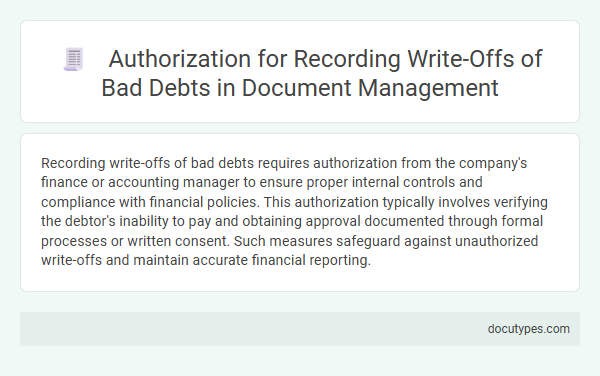Recording write-offs of bad debts requires authorization from the company's finance or accounting manager to ensure proper internal controls and compliance with financial policies. This authorization typically involves verifying the debtor's inability to pay and obtaining approval documented through formal processes or written consent. Such measures safeguard against unauthorized write-offs and maintain accurate financial reporting.
Introduction to Authorization for Recording Write-Offs
Authorization for recording write-offs of bad debts is a critical control measure in financial management. It ensures that only approved transactions are removed from accounts receivable.
You need explicit approval from designated personnel or departments before writing off any bad debt. This authorization safeguards against errors and potential fraud in financial records.
Importance of Managing Bad Debts in Document Workflows
Authorization for recording write-offs of bad debts is crucial to maintain financial accuracy and prevent fraudulent activities. Proper management of bad debts within document workflows ensures transparency and accountability in financial reporting.
- Controlled Authorization - Ensures only designated personnel approve write-offs to safeguard company assets.
- Audit Trail - Maintains detailed records of approvals to facilitate internal controls and external audits.
- Compliance Assurance - Adheres to regulatory standards and accounting principles for accurate financial statements.
Effective authorization processes streamline bad debt management and enhance overall document workflow integrity.
Authorization Policies for Bad Debt Write-Offs
Authorization for recording write-offs of bad debts must be clearly defined within an organization's policies to prevent financial discrepancies. Proper authorization ensures that only designated personnel can approve write-offs, maintaining accurate financial records.
- Defined Approval Hierarchy - Authorization policies specify which roles or positions have the authority to approve bad debt write-offs based on predefined limits.
- Documentation Requirements - Policies require thorough documentation to support the write-off, including evidence of collection efforts and management approval.
- Periodic Review and Audit - Regular reviews and audits of write-off transactions ensure compliance with authorization procedures and identify any unauthorized actions.
Criteria for Approving Write-Off Requests
Authorization to record write-offs of bad debts typically requires approval from designated management or a finance committee. The criteria for approving write-off requests include verifying that the debt is genuinely uncollectible and that all collection efforts have been exhausted.
Your write-off request must be supported by accurate documentation, such as payment history and communication records. Approval often depends on the amount of the debt, with higher amounts requiring senior management or board-level consent.
Step-by-Step Process for Write-Off Authorization
Authorization to record write-offs of bad debts requires approval from designated financial officers or management to ensure proper control and compliance. Your organization may have a formal step-by-step process involving documentation review, verification of debt status, and sign-off by the credit or finance department. This structured authorization helps maintain accurate financial records and prevent unauthorized write-offs.
Roles and Responsibilities in Debt Write-Off Approval
Authorization to record write-offs of bad debts typically involves strict oversight to ensure accuracy and compliance. Financial controllers or senior management often hold the authority to approve these write-offs.
Roles and responsibilities in debt write-off approval are clearly defined to maintain financial integrity. Your finance department usually initiates the write-off request after thorough assessment and documentation. Approval is granted by designated individuals such as the CFO or accounts receivable manager following company policies and audit requirements.
Documentation and Record-Keeping Requirements
| Authorization Requirement | Proper approval from the finance manager or designated authority is essential before recording write-offs of bad debts. |
|---|---|
| Documentation Needed | Written approval documents, detailed debt aging reports, and evidence of debt collection efforts must be maintained. |
| Record-Keeping Standards | Records should include authorization forms, correspondence related to the debt, and adjustments made in the accounting system. |
| Compliance | Ensure adherence to company policies and relevant accounting standards when documenting write-offs. |
| Your Role | You must secure all necessary approvals and maintain thorough documentation to support audit and legal requirements. |
Controls to Prevent Unauthorized Write-Offs
Authorization to record write-offs of bad debts typically requires approval from senior financial management or the finance director. Controls to prevent unauthorized write-offs include implementing a multi-level approval process and maintaining a detailed audit trail of all write-off transactions. Access to write-off capabilities is restricted through role-based permissions within the accounting system to ensure accountability and compliance.
Compliance and Audit Considerations
What authorization is required to record write-offs of bad debts? Proper authorization involves approval from designated financial controllers or senior management to ensure compliance with company policies. This process supports audit trails and maintains regulatory adherence.
What Authorization Is Needed to Record Write-Offs of Bad Debts? Infographic

